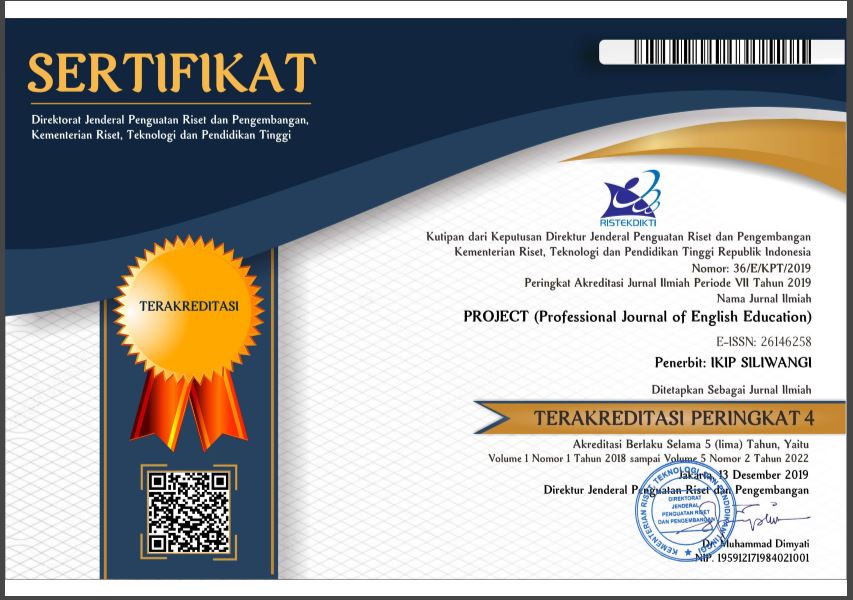Students' Speaking Anxiety in EFL Classroom
DOI:
https://doi.org/10.22460/project.v2i4.p581-587Abstract
This study investigated the students’ speaking anxiety in the first grade of vocational high school. It emphasized on the level, the causal factors and the strategy to reduce the anxiety. It applied descriptive qualitative to answer the research questions. The data were obtained through questionnaire and interview. The Foreign Language Classroom Anxiety Scale (FLCAS) questionnaires and interview were administered to 30 students. It was revealed that [a1] the factors that make students feel anxious in speaking in English were lack of preparation, afraid of left behind in understanding the material or what the teacher talks about, afraid of making mistakes, afraid of being laughed by his/her friends, unconfident to spell, pronounce and select the words in English. It was also found that there were eight students in level Relaxed, twelve students in level Mildly Anxious, and ten students in level Anxious. Last, the strategies that students should do to reduce their anxiety are do more preparation before speaking, try to be more confident in saying English words, and pronunciation practice.
Â
Keywords:Â Â Speaking, Speaking anxiety, EFL Classroom.
 [a1]It was revealed that
References
Apsari, Y., & Satriani, I. (2016). Students’Perception Toward The Implementation Of Digital Storytelling In Teaching Writing. P2M STKIP Siliwangi, 3(2), 97-102.
Apsari, Y., Syathroh, I. L., & Rizqiya, R. S. (2017). Promoting English Teachers’ Professional Development (TPD) Through The Practice of Lesson Study. OKARA: Jurnal Bahasa Dan Sastra, 11(2), 303-318.
Apsari, Y. (2018). REFLECTIVE READING JOURNAL IN TEACHING WRITING. Indonesian EFL Journal, 4(2), 39-47.
Fujii, S. (2016). A Conceptualization of Strategies for Reducing Students’ Language Anxiety. HELES JOURNAL, 15, 3–19. Retrieved from https://www.jstage.jst.go.jp/article/helesje/15/0/15_1/_article
Gardner, R. C., & MacIntyre, P. D. (1993). A Student’s Contribution to Second Language Learning. Part II: Affective Variables. Language Teaching, 26(1), 1–11. https://doi.org/https://doi.org/10.1017/S0261444800000045
Horwitz, E. K., Horwitz, M. B., & Cope, J. (1986). Foreign Language Classroom Anxiety. The Modern Language Journal, 70(2), 125–132. Retrieved from http://www.jstor.org/stable/327317
Mauludiyah, Y. (2014). The Correlation Between Students’ Anxiety and Their Ability in Speaking Class. Stated English department at IAIN Tulungagung.
Musthachim, A. (2014). Students’ anxiety in learning english: a case study at the 8th grade of SMPN 9 South Tangerang. The State Islamic University Syarif Hidayatullah.
Parmawati, A. (2018). Using Analytic Teams Technique to Improve Students’ Speaking Skill. Edulitics (Education, Literature, and Linguistics) Journal, 3(2), 21–25.
Sartika, D. (2016). Teaching Speaking Using The Information GAP Technique. English Education Journal, 7(3), 273–285. Retrieved from http://www.jurnal.unsyiah.ac.id/EEJ/article/view/4583.
Sulastri, & Ratnawati. (2018). Students’ Strategies in Reducing Anxiety in Learning English. ELS Journal on Interdisciplinary Studies on Humanities, 1(4), 423–428. Retrieved from http://journal.unhas.ac.id/index.php/jish
Ur, P. (1996). A Course in Language Teaching. UK: Cambridge University.




